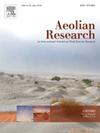Climate changes revealed from the aeolian sediments in the Menyuan Basin, northeastern Qinghai-Tibet Plateau
IF 3.4
3区 地球科学
Q2 GEOGRAPHY, PHYSICAL
引用次数: 0
Abstract
Aeolian sediments are a crucial component of Earth’s surface and serve as a significant terrestrial climate archive. The Menyuan Basin is a sensitive region for the interaction between the monsoons and Westerlies in the northeastern Qinghai-Tibet Plateau, where loess is extensively distributed, rendering it an ideal area for investigating climatic processes. In this study, climate changes in the Menyuan Basin since 40 ka are reconstructed using proxy records and luminescence dating obtained from the Yahecun profile. Our results show that the Menyuan Basin experienced a dry and cold climate from 40 to 16 ka, a continuous increase in moisture and temperature from 16 to 4.4 ka, and a relatively mild climate since 4.4 ka. The temperature variations in the Menyuan Basin are primarily driven by solar insolation; after 6 ka, the increase in the greenhouse gas concentrations contributed to higher temperatures. Precipitation in the region is governed by changes in the Westerlies and monsoons. During the glacial period, the summer monsoon weakened, and the transport of westerly water vapor decreased, resulting in reduced precipitation in the Menyuan Basin. Following the glacial period, an intensified summer monsoon and increased westerly water vapor transport collectively led to heightened precipitation. After 5 ka, the strengthening of the Westerlies likely sustained high precipitation in the Menyuan Basin. The intensity of winter monsoons in the Menyuan Basin is influenced by high-latitude insolation, with reduced high-latitude insolation after 6 ka leading to enhanced winter monsoons.
青藏高原东北部门源盆地风成沉积物的气候变化特征
风成沉积物是地球表面的重要组成部分,是重要的陆地气候档案。门源盆地是青藏高原东北部季风与西风带相互作用的敏感区,黄土分布广泛,是研究气候过程的理想区域。本文利用雅河村剖面的代用记录和发光测年资料,重建了40ka以来门源盆地的气候变化。结果表明:40 ~ 16 ka为干冷气候,16 ~ 4.4 ka为持续增温增湿气候,4.4 ka以来为相对温和气候。门源盆地温度变化主要受太阳日照驱动;6 ka以后,温室气体浓度的增加导致温度升高。该地区的降水受西风带和季风的影响。冰期夏季风减弱,西风水汽输送减少,导致门源盆地降水减少。冰期之后,夏季风的增强和西风水汽输送的增加共同导致降水增加。5 ka后,西风带的增强可能维持了门源盆地的高降水。门源盆地冬季季风强度受高纬度日照影响,6 ka后高纬度日照减少导致冬季季风增强。
本文章由计算机程序翻译,如有差异,请以英文原文为准。
求助全文
约1分钟内获得全文
求助全文
来源期刊

Aeolian Research
GEOGRAPHY, PHYSICAL-
CiteScore
7.10
自引率
6.10%
发文量
43
审稿时长
>12 weeks
期刊介绍:
The scope of Aeolian Research includes the following topics:
• Fundamental Aeolian processes, including sand and dust entrainment, transport and deposition of sediment
• Modeling and field studies of Aeolian processes
• Instrumentation/measurement in the field and lab
• Practical applications including environmental impacts and erosion control
• Aeolian landforms, geomorphology and paleoenvironments
• Dust-atmosphere/cloud interactions.
 求助内容:
求助内容: 应助结果提醒方式:
应助结果提醒方式:


